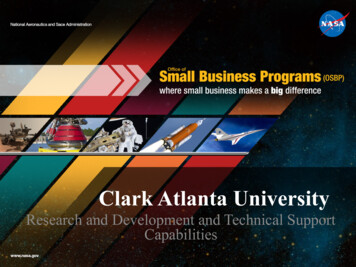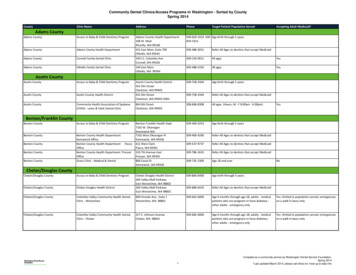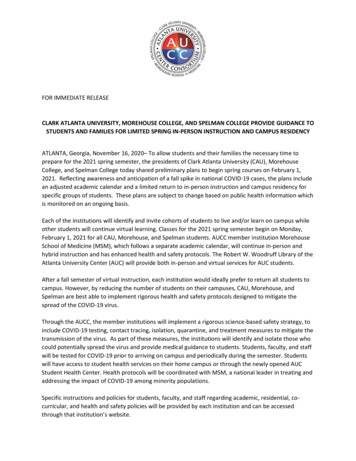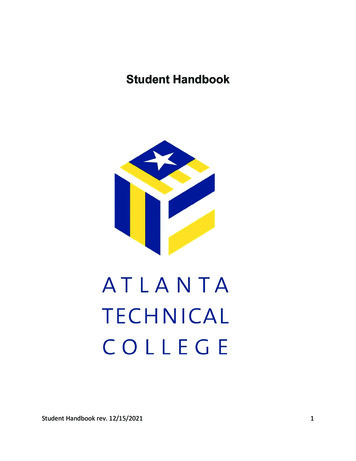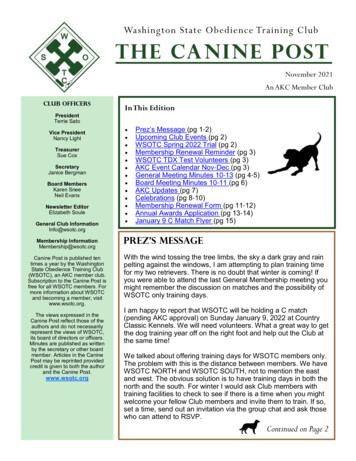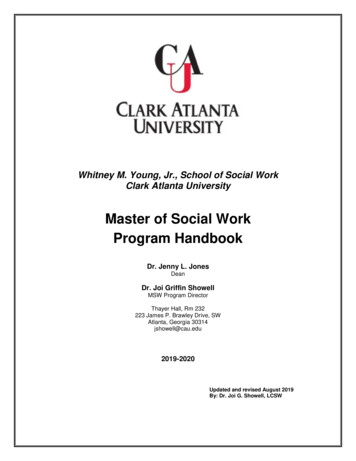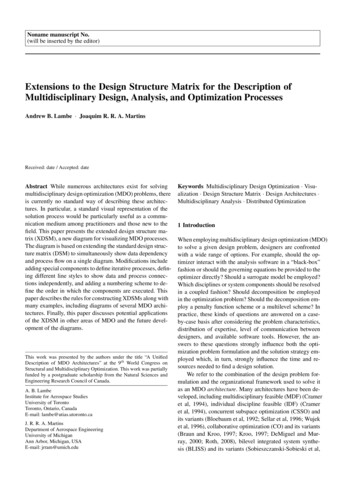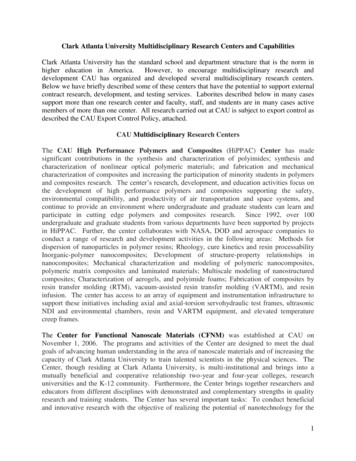
Transcription
Clark Atlanta University Multidisciplinary Research Centers and CapabilitiesClark Atlanta University has the standard school and department structure that is the norm inhigher education in America.However, to encourage multidisciplinary research anddevelopment CAU has organized and developed several multidisciplinary research centers.Below we have briefly described some of these centers that have the potential to support externalcontract research, development, and testing services. Laborites described below in many casessupport more than one research center and faculty, staff, and students are in many cases activemembers of more than one center. All research carried out at CAU is subject to export control asdescribed the CAU Export Control Policy, attached.CAU Multidisciplinary Research CentersThe CAU High Performance Polymers and Composites (HiPPAC) Center has madesignificant contributions in the synthesis and characterization of polyimides; synthesis andcharacterization of nonlinear optical polymeric materials; and fabrication and mechanicalcharacterization of composites and increasing the participation of minority students in polymersand composites research. The center’s research, development, and education activities focus onthe development of high performance polymers and composites supporting the safety,environmental compatibility, and productivity of air transportation and space systems, andcontinue to provide an environment where undergraduate and graduate students can learn andparticipate in cutting edge polymers and composites research. Since 1992, over 100undergraduate and graduate students from various departments have been supported by projectsin HiPPAC. Further, the center collaborates with NASA, DOD and aerospace companies toconduct a range of research and development activities in the following areas: Methods fordispersion of nanoparticles in polymer resins; Rheology, cure kinetics and resin processabilityInorganic-polymer nanocomposites; Development of structure-property relationships innanocomposites; Mechanical characterization and modeling of polymeric nanocomposites,polymeric matrix composites and laminated materials; Multiscale modeling of nanostructuredcomposites; Characterization of aerogels, and polyimide foams; Fabrication of composites byresin transfer molding (RTM), vacuum-assisted resin transfer molding (VARTM), and resininfusion. The center has access to an array of equipment and instrumentation infrastructure tosupport these initiatives including axial and axial-torsion servohydraulic test frames, ultrasonicNDI and environmental chambers, resin and VARTM equipment, and elevated temperaturecreep frames.The Center for Functional Nanoscale Materials (CFNM) was established at CAU onNovember 1, 2006. The programs and activities of the Center are designed to meet the dualgoals of advancing human understanding in the area of nanoscale materials and of increasing thecapacity of Clark Atlanta University to train talented scientists in the physical sciences. TheCenter, though residing at Clark Atlanta University, is multi-institutional and brings into amutually beneficial and cooperative relationship two-year and four-year colleges, researchuniversities and the K-12 community. Furthermore, the Center brings together researchers andeducators from different disciplines with demonstrated and complementary strengths in qualityresearch and training students. The Center has several important tasks: To conduct beneficialand innovative research with the objective of realizing the potential of nanotechnology for the1
benefit of the Nation and all humanity. To increase the number of students pursuing graduateand undergraduate degrees in the natural and physical sciences by increasing the number ofstudents, in the precollege and two-year college pipeline, who will pursue degrees in the naturaland physical sciences. To enhance the productivity of participating researchers by a program ofinfrastructure enrichment. Included among the Center’s expanding list of institutional partnersare the Atlanta area school systems, Cornell University, Emory University, Perimeter Collegeand iThemba Labs in South Africa.The Center for Cancer Research and Therapeutic Development (CCRTD) was developed asa vehicle of communication and collaboration for scientists at CAU who are interested in anyaspect of cancer research. The CCRTD is one of the nation’s leading prostate cancer researchcenters. The CCRTD is currently supported by the Research Center in Minority Institutions(RCMI) program of the National Center for Research Resources at the National Institutes ofHealth along with several other grants from NIH and DOD. The biomedical research projectsrange from studies on signal transduction mechanisms to the development of better drug deliverysystems. This core group collaborates with other scientists at the University who are involved inprojects that complement and enhance the center. CCRTD is currently working to recruit socialand behavioral scientists who will explore the ethical, legal and social implications of biomedicalresearch in general and cancer research in particular. In addition, the CCRTD recentlyestablished a Cancer Genomics Center at CAU working in collaboration with Georgia Tech andSt. Joseph’s Health System. It is the goal of the CCRTD to significantly increase the body ofknowledge on cancer research, particularly as these diseases disproportionately impact thepopulation mainly served by Clark Atlanta University, African-Americans.The Center for Theoretical Studies of Physical Systems (CTSPS) was established in 1991 by amulti-million dollar grant through the NSF CREST program, although the center has receivedfunding from other federal and state agencies, and the private sector. Research at the CTSPS isconducted through a dynamic clustering of researchers in the areas of atomic and moleculartheory, and condensed matter, mathematical physics/applied mathematics, and wavelet analysisand multidimensional signal processing. Some of the strengths of this center include simulationand modeling, low-energy scattering theory, solid-state theory, image processing, andmathematical physics theory.CTSPS has extensive research partnerships and collaborations to conduct cutting edge researchat CAU, and has established a mechanism to educate and produce African-American M.S. andPh.D. students in STEM fields. Several CSTPS graduate students have completed Ph.D.s atmajor research universities such as Rice University, Georgia Tech, University of Michigan andUniversity of Maryland. CSTPS has numerous collaborations domestically and abroad withpremier research institutions such as Harvard University, University of California-Berkeley,MIT, Stanford, University of Benin, ICTP (Italy), the African Laser Centre (Pretoria), andiThemba Labs (South Africa). CSTPS is an active member of the African Laser Centre which isa virtual center of excellence and one of the strongest combinations of human and physicalinfrastructure for science in Africa that links scientists and laser facilities in six African nations.In addition, CSTPS attracts noteworthy visiting scientists and graduate students globally tostrengthen and impact its diverse research capability, and further strengthen these partnerships.Recently, CSTPS co-organized with Caltech and African Laser Centre, the first US-African2
Institute on Photon Interactions (Durban) and with iThemba Labs, the Nanosciences Workshop(Cape Town). CTSPS also collaborates with the National Energy Research Scientific ComputingCenter (NERSC) facility at Lawrence Berkeley National Lab, which is supported by the U.S.DOE, and the Queen’s University of Belfast, UK for access to supercomputers for simulationand modeling research activities. High school minority students and teachers have beenimpacted by the outreach activities of CTSPS such as Peer Tutorial program, Summer ResearchApprenticeship program, and the Summer Enrichment and Summer Transportation Instituteprograms. CTSPS, characterized by excellent researchers, continues to publish in peer reviewedjournals and attract funding for basic research.Center of Academic Excellence in National Security Studies (CAENS)The importance of analytical skills that apply across a variety of disciplines has becomeincreasingly evident in recent years. Numerous studies have indicated the need for largernumbers of intelligence analysts with diverse backgrounds and ethnicities. The existinginfrastructure for training is limited by the difficulty of scaling up from previous levels to thenew demands for analysts. Academic institutions have an important role to play in fulfillingthese requirements. As the challenges of the new century unfolds government agencies, privateindustry, consulting companies, and think tanks will increasingly rely on this new cadre ofemployees in formulating policies, and developing business strategies who are responsible globalcitizens, while at the same time are protecting the competitive interests of the U.S. Governmentand organizations. The Center for Academic Excellence in National Security Studies (CAENS)at Clark Atlanta University (CAU) was established in 2005 under funding provided by the Officeof the Director of National Intelligence (ODNI) with the specific purpose of developing a newcadre of students capable of fulfilling this role. CAU was one of the first four centers funded inthe Intelligence Community Centers of Academic Excellence (IC-CAE) Program. To fulfill thismission, CAENS has developed an innovative, interdisciplinary program of study, research, andoutreach. This program has attracted faculty from disciplines across CAU, encompassingmultiple schools and departments. Faculty members from the departments of History, English,Computer and Information Science (CIS), Public Administration, Psychology, Physics, PoliticalScience, Business, and Sociology among others have participated in this program. The CAENSprogram includes the following key components: 1. Intelligence Community (IC) ScholarProgram; 2. Curriculum Development; 3. High School Outreach; and 4. Faculty/StudentResearch in areas of interest to the IC community. The IC Scholars include high achievingstudents from CAU, Spelman and Morehouse colleges and Georgia Tech. Included in the weeklysessions were scholarly lectures, writing and research, and leadership and professionaldevelopment. Since its inception in 2005, CAENS Studies has had a total of 49 active ICscholars.An allied activity conducted by the Department of Computer and Information Science (CIS)under CAENS has curriculum activity focused on the incorporation of Information Assurance(IA) organically into the CIS course of study and IA related research. The CIS IA curriculum,course of study, and facilities has been recognized as conforming to IA national educationalstandards by the Department of Defense/National Security Agency (DoD/NSA). DoD/NSAcertified the CAU/CIS Department as a Center of Academic Excellence (CAE) in InformationAssurance in 2005, and re-certified in 2008 (CAU was the first HBCU to be recognized as an IACAE).3
The Center of Excellence in Supply Chain Management is the newest center of excellence atCAU having been approved in 2015. The demand for professionals in Supply ChainManagement (SCM) is rapidly growing as firms are realizing improved efficiency, lower costsand increased profitability, resulting from strong supply chain practices. With this in mind, theSCM program at CAU is designed to constantly challenge students by exposing them toknowledge and learning inside and outside of the classroom. CAU offers students businessdegrees in Supply Chain Management at both the undergraduate and graduate level (MBA).Since the program’s inception in 2003, our vision has been to focus on the intellectual andpersonal development of each student and to prepare graduates to excel in their chosen endeavorsour goal is to be the Industries’ Preferred Long-term Supplier of Highly Qualified ProfessionalHires.To achieve our objective, we remain committed to developing high achieving, critical thinkingSCM graduates who innovative ideas and practices, with a disposition to serve. Our appliedcross-functional curriculum is taught by faculty and business professionals with expertise insupply chain management. We continuously update our curriculum to maintain a leading-edgefocus.4
Clark Atlanta Major University Laboratory FacilitiesThe following laboratories and facilities are housed in the 200,000 sq. ft. Cole Research Centerfor Science and Technology and the adjacent 30,000 sq. ft. Environmental Science andEngineering Research Building.INNOVATION LAB 3D PRINTER/ADDITIVE MANUFACTURING (AM)The CAU innovation lab is designed to support students and faculty as well as facilitate technologytransfer to the market place. As part of CAUs Innovation Lab we are in the process of developing a3D printing/additive manufacturing laboratory. When completed in October 2016 the InnovationLab will have fifteen (15) 3D printers with the capabilities listed in the table below. The lab isdesigned with room for further expansion in the future. The importance of 3D printing and AM tofuture NASA missions is evidenced by the deployment of a 3D printer to the ISS to carry out AM in alow gravity, closed environment. AM, is a key technology for rapid prototyping, new productdevelopment, and production of low volume parts for a variety of applications. For long duration spaceflights and NASA missions, recycling of plastics and 3D printing for replacement parts, tools,components, and habitat construction will be a key enabling Zortrax M200 4UP mini 2 UPM-0021uPrint SE Plus1ZPrint 6501Printrbot Simple-Metal Build area: 8 x 8 x 8 inchesFully automated platform leaving and height sensing100-micron print resolutionPolymers: PLA and ABSBuild area: 7.8 x 7.8 x 7.2 inchesHeated build platePolymers: ABS, ABS/polycarbonate, Nylon,PETG/FiberglassBuild area: 8 x 8 x 10 inchesPolymers: ABSBuild area: 8 x 6 x 6 inches0.254 mm (.010 in) or .330 mm (.013 in)Polymers: ABSBuild area: 10 x 15 x 8 inchesLayer Thickness: 0.0035-0.004 inchesPolymers: PLA and ABSBuild area: 6 x 6 x 8 inchesAuto LevelingLayer Thickness: 0.4 mmPolymers: PLA5
COMPOSITES PROCESSINGProcessing capabilities include autoclave processing, Resin Transfer Molding (RTM), VacuumAssisted Resin Transfer Molding (VARTM), Thermoforming and Compression Moldingtechniques. The labs also have polymer processing capabilities, including extrusion, batchmixing, blending and alloying.InstrumentWabash Press Model G30H-15CPX 30 Ton 450 C 15” x 15”platensAutoclave - MiniBonder I 600 psi 1000 F 18” diameter x40”Thermoforming HydrotrimLabformerResin Injector – 550 F 2000 cc 500 cc/minWalk-In Oven –Wisconsin 800 F 6’x6’x6’Haake Extruder /Mixer 500 CComposites Processing CapabilitiesSpecific Processes CompressionMolding Resin TransferMolding Powder CoatedTextiles Hand Lay-up VARTM withA/C Thermoforming Powder CoatedTextiles Resin TransferMolding RTM VARTM Vacuum BagOven Curing Nano-composites Sheet and Rod6
THERMAL ANALYSISThe Thermal Analysis Laboratory provides Differential Scanning Calorimeter (DSC), Thermogravimetric Analysis (TGA), Dynamic Mechanical Analysis (DMA/DMS) and Thermomechanical Analysis (TMA). The Thermal Analysis Laboratory allows determination of degreeof cure, heat of reaction, cure kinetics, and glass transition temperature (Tg).Thermal Analysis CapabilitiesInstrumentSpecific TestsDifferential Scanning Calorimeter Glass TransitionTA instruments Q 2000 DSCTemperature (Tg) Melting Temperature(Tm) Crystallization time andtemperature Percent crystalline Heats of fusion andreaction Specific heat and heatcapacity Oxidative stability Cure kineticsThermogravimetric Analysis Thermal StabilityTA instruments Q50 TGA Thermo-oxidativestability Decompositiontemperature Degradation kineticsThermomechanical Analysis CTETA instruments Q400 TMA Glass Transition (Tg)Dynamic Mechanical AnalysisTA instruments AGRS II DMTA Modulus (E) Tan delta Glass Transition (Tg)MECHANICAL CHARACTERIZATIONCapabilities include ASTM, SACMA, CMC, and MIL-STD tensile, compression, torsion,flexural, and shear quasi-static as well as high cycle dynamic (fatigue) testing. Digitallycontrolled convection ovens capable of elevated/sub-zero (-129 C to 600 C) temperaturesalong with high temperature capacitance extensometers allow experiments to be conducted atextreme temperatures. Long focal length microscope allows for the observation andmeasurement of cracks and damage in monolithic and composite materials.7
Mechanical Characterization CapabilitiesInstrumentSpecific TestsMTS 810 axial and axial Un-Notched Tensiontorsional 100 kN servo Un-Notched Compressionhydraulic test frames Open Hole Compression100 kN Instron electro Filled Hole Compressionmechanical test frames IITRI CompressionMTS Testar II Controllers Open Hole TensionMTS 647 Hydraulic Grips Tension-Tension FatigueHigh Temperature Grips Tension-CompressionSurfalloy WedgesFatigueMTS 601 Temp Chamber Torsion FatigueVishay 2100 Conditioners Flexural (Bending)Capacitance ExtensometerPropertiesMTT 605 IITRI Fixture Fracture ToughnessTestingMTT 642.1 Bend FixtureWyoming WTF-2R Fixture Crack GrowthMeasurementWyoming 605.26A-21 Interlaminar (Short-Beam)SACM.00388.30 FixtureShearSACM.00188.12 Fixture In-and-Out of plane ShearBOEI.07260.2 Fixture IOSIPESCU ShearBoeing IMP.0011 Impact Elevated TemperatureQuestar QRMS-II/670TestingShimadzu CM227-083 Sub-Zero TestingTenney Benchmaster Low Velocity ImpactSDI-2454 Flaw DetectorTesting Compression After Impact Vickers Hardness Testing DamageDetection/Monitoring Temperature/HumidityCondition Ultrasonic (NonDestructive) TestingSATEC Model D 20kN High Temperature CreepTestingSATEC DL 2 kN Accelerated TestingTCC Chamber Durability TestingTCS1200 Controller Viscoelastic Properties8
RHEOLOGYThe Rheology lab functions in parallel with the thermal analysis laboratory. The rheologyequipment allows determination of the viscoelastic properties of polymeric materials as it relatesto molecular structure, processibility, physical properties and end use performance. Thermalimaging equipment can be used to determine the thermal profiles of processing molds andpolymer melts.InstrumentRheologyTA instruments :AGRS II DMTAHaake Rheocord 90Rosand CapillaryRheometerKayness Model D7051Rheology and Thermal ImagingSpecific Tests Melt Rheology Cure Modeling Solid StateRheology Cure Kinetics Cure Modeling Mixing Melt Rheology Cure Modeling Solid StateRheology Melt Index9
CHEMICAL ANALYSISThe Chemical Analysis laboratories have the ability to analyze chemical compounds usingInfrared spectroscopy, Raman spectroscopy and/or Nuclear Magnetic Resonance. These labs areimportant for allowing determination of the chemical make-up of polymer resins used in polymermatrix composites, the determination of side or by-products generated during cure, andmiscellaneous trouble shooting into chemistry related problems.InstrumentFT-IR Solids Powders Fibers Polymers Liquids Thin Films GasesRammanBruker; SENTERRARaman Microscope; Powders Fibers Polymers Liquids Thin FilmsNMRBruker 500 ADVANCE IIIwith solid and liquidprobesBruker 400 ADVANCE Solutions Multinuclear Solid StateX-Ray diffractionPanalytical EmpyreanXRD Powders and ThinFilms Polycrystalline andNanoporous materials Nancomposites Colloidal dispersions PolymersSurface AnalysesMicromeritics ASAP 2020Chemical Analysis CapabilitiesSpecific Tests KBr Pellet Nujol Mull Ambient Diffuse Reflectance Standard Raman Scattering 2D and 3D mapping 1D & Double resonance 2-D NMR Magic Angle Spinning WAXS in reflection andtransmission geometry SAXS in transmissiongeometry WAXS and SAXS at nonambient temperature 2D- SAXS with 3D areadetector XRD, SAX, andWAXS Hot Stage BET surface area and Poresize analysis. Chemisorption10
Agilent Chromatography QC/QAand Mass Spectrometry GC Analysis of complex mixtures6890N /MSD 5973Nof organic componentsAgilent HPLC with UV Analysis of complex mixturesand Refractive Indexof volatile, semi- and nonDetectorsvolatile organic componentsPerkin Elmer DRC-e Metals analysis to ppb and pptICP/MSlevels.Elemental(metals) analysisBruker Dimension AFM Imaging techniques forFastScan AFMfluids Imaging of polymer latexesand biological samples Imaging of extremely soft anddelicate samples Quantitative nanomechanicalproperty mapping: Electrical property pertyinformation(deformation, adhesion, DMTmodulus, and dissipation). Variable temperature stage(-35 to 250 C)Horiba LA550 Particle size Particle size from 1 nm to 6analyzerµm and a concentration rangefrom ppm up to 40% solidsCENTER FOR CANCER RESEARCH AND THERAPEUTICS DEVELOPMENT(CCRTD) CORE FACILITIESMolecular Biology Core: The core offers polymerase chain reaction (PCR) instrumentsincluding Real-Time PCR machine (Bio-Rad), Liquid Scintillation Counter (BeckmanCoulter), Lyophilizer and Freeze-Dryer for biological samples, Cell Electroporator, high-speedand ultra-high-speed Centrifuges, ultra-sensitive Balances, and other supporting equipment.DNA and RNA quantification is carried out on Spectrophotometers such as single-cuvette(DU650, Beckman Coulter), 96-well plate based and nano-drop. DNA, RNA and protein isvisualized, digitized, and quantified using Gel Documentation system (Bio-Rad), Multi-ModeImager Typhoon 9410, in fluorescent, luminescent, UV, or visible wavelengths; time-resolvedfluorescence option is available on BioTek Plate Imager and Fuji LAS3000 (chemiluminescence). For X-Ray imaging, an Automated X-Ray processor and Dark Room isavailable; radioisotope imaging is also supported on Typhoon 9410. The core also has a LaserCapture micro-dissection system (Leica) to enable micro-dissection of specific regions of fixed/frozen tissue for subsequent DNA/RNA/Protein analysis. Additional equipment include:Sonicator (Misonix 3000), speedvac (Thermosavant SPD11V), UV stratalinker.Collaborative Center for Cancer Genomics (CCGC): The CCGC established in Clark AtlantaUniversity is a collaborative effort between the CCRTD and the Ovarian Cancer Institute atGeorgia Tech University (OCIGT). The operation is based on Next-Generation sequencingtechnology for global genome composition, inter-individual variation, and global gene11
expression. Next-Generation sequencing technology is based on SOLiDTM4 (AppliedBiosystems) at CCRTD. This facility is fully functional and is used for genomic analysis ofovarian, prostate and pancreatic cancer patients. Additional equipment include: DNAhydroshear, EZ bead system, PCR machine, Covaris sonicator, Bioanalyzer (Agilent) and Datastorage server.Prostate Cancer Bio-repository: The prostate cancer bio-repository at CCRTD currently hasmore than 300 prostate cancer and normal prostate core biopsies, serum, buffy coat and purifiedDNA from Caucasian and African American subjects. When possible, serum, urine and bloodare also collected as follow up visits and stored appropriately. All samples have DOB, PSA andstage and Gleason grade for cancer patients. The samples are collected in collaboration withPiedmont Hospital, Atlanta by Drs. Nikhil Shah, MD and Rajesh Laungani, MD. These sampleswill be made available for this study.Cell Biology: Cell Biology core have complete facilities for cell growth, handling, and storage.Cell Culture Facility maintains Cell Storage Cryo Tanks with uninterruptable liquid nitrogensupply and two separate Cell Culture rooms fully equipped with eight temperature and CO2controlled Cell Growth Incubators, two Biological Safety Cabinets, two late model InvertedDigitized Microscope (Zeiss), one of which is fluorescence-enabled and possesses Z-stacking andlive cell imaging capabilities, automated Cell Counter (Nexcelom Bioscience), and refrigeratedstorage for media and cell culture reagents. The core also recently acquired Accuri flowcytometer, BD JAZZ FACS (Fluorescence assisted cell sorter) and ZEISS confocal microscope.Proteomics: The core facilitates Cell and protein Fractionation using Ultracentrifuges (BeckmanCoulter), Fast Protein Liquid Chromatography (FPLC), Two-Dimensional ProteinElectrophoresis (Protean II, Biorad), Gel Documentation Systems (one Bio-Rad and one FujiMedical) and HPLS (Shimadzu).Histology Core Laboratory: CCRTD houses several major instruments to support Histologicalstudies and support cell, and molecular visualization applications. The core has InvertedDigitized Microscope (Zeiss) of general use, plus an advanced Fluorescence-enabled InvertedDigitized Microscope with Z-stacking and Live Cell Imaging modules (Zeiss) for advancedapplications including In Situ Hybridization (ISH) and Immunohistochemistry (IHC), in additionto Zeiss microscope above. Additional equipment include: Tissue Embedding and slicing(LKB), Microtome and ultra-microtome, equipments for tissue and slide processing, Automoateslide stainer (DAKO).Bioinformatics Core: The core provides many crucial applications for in silico research. Theyinclude general bioinformatics programs intended for sequence analysis of nucleic acids andproteins (Vector NTI Advance) and more specialized programs including Gene ExpressionAnalysis software (Gene spring and real-time PCR primer design program; Beacon Designer, byPremier Biosoft). The core also houses a High-End Computer Workstation intended exclusivelyfor bioinformatics support.The computational systems are networked with workstations and CCRTD data storage serversupported by CAU Office of Information Technology. The server is used for storage, backup,and retrieval of whole genome sequence data, Affymetrix data files, real-time PCR data, imagedata from Typhoon and Bio-Rad Imagers, micro plate readers, etc. Furthermore, it is used fordata sharing and transfer both within CCRTD, external collaborators, and granting agencieshousing an ftp site with supplementary experimental data generated within CCRTD.12
Biostatistics Core: The Biostatistics unit is the component of the Center for Cancer Researchand Therapeutic Development (CCRTD), and is engaged in a large quantity of statisticalcomputing and simulation for research and teaching purposes. The statistical computing consistsof designing experiments and statistical analysis using equipment that are spread over variousnetworks and one computer lab that are interconnected via the campus backbone. Windows 7and Windows XP are the supported Operating Systems with a wide range of computingequipment from Dell, HP and other manufacturers. The University’s Office of Information andTechnology Center maintains the hardware, security environment and software builds ofcomputing systems.The Biostatistics unit owns and maintains about 7 computers and networked peripherals, anduses a range of statistical, imaging, GIS and genetics applications used to analyze data. The listof applications consists of Arcview GIS, Mathematica, Systat, SPSS, Stata, and NCSS.Animal Housing: The local shared animal facility at Morehouse school of Medicine and Animalfacility at Mercer University are routinely used for mice studies.Clark Atlanta University GIS ProgramGeographic Information Systems (GIS) and satellite remote sensing have been identified asimportant aspects of most academic disciplines in both curriculum design, research andcommunity service. Interest in remote sensing and GIS is widespread in the academiccommunity. Advanced GIS and remove sensing technologies are central to the immediate andlong term needs of the society. Both research and education in this challenging area is a criticalendeavor.The general goal of the CAU GIS Program is advancing geo-information technology educationat Clark Atlanta University, including geographic information systems (GIS), satellite remotesensing, digital remote sensing image processing, image pattern recognition, analysis models,integration of remote sensing and GIS, computer assisted cartography, and global positioningsystems (GPS). While these technologies have become widely used, corresponding educationprograms need to be updated and new programs need to be developed. Specifically, offering acredential in geospatial technologies and methods will set CAU apart from other HBCUs andinstitutions.GIS LaboratoryThe CAU GIS Laboratory is located in the Thomas Cole Science and Research Center, and isadministered through the Department of Sociology and Criminal Justice and a full-time GISCoordinator. The lab consists of a single, secure classroom with 14 Dell Precision desktopcomputers in a network environment, one large-format scanner, one color laser printer, a largeformat laminator, and one 36” HP Plotter. A portable Wacom Cintiq tablet is also available fordigitizing instruction. The instructor’s station is configured with a Dell Precision machine, aSmartBoard system, and a whiteboard wall.Student computers are equipped with:ArcGIS Desktop 10.3.1 (14 machines): the leading GIS software, used by institutions andorganizations world-wideMicrosoft Office 10 (14 machines)13
Adobe Suite 2015 software (42 machines): includes Acrobat, Dreamweaver, Illustrator,InDesign, Lightroom, Muse, Photoshop, and Premier.SPSS 23 (14 machines): statistical software for the social sciencesAtlas.Ti 7 (5 machines): Quantitative Data Analysis softwareArcGIS Server 10.3.1 (1 machine): for publishing geospatial services to the internet.The laboratory is open for student use Monday – Friday, 10 am – 4 pm, and by prior arrangementwith the GIS Coordinator.14
contract research, development, and testing services. Laborites described below in many cases support more than one research center and faculty, staff, and students are in many cases active members of more than one center. All research carried out at CAU is subject to export control as described the CAU Export Control Policy, attached.
